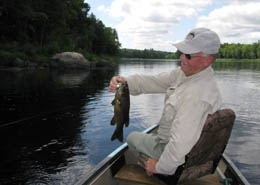
Dan with a popper-caught, typical-size Maine smallie
BOOK EXCERPT–
It was a couple summers ago. My pal Dan and I loaded up the car with a big canoe and lots of tackle and headed northeast. Though the route through Vermont was slow, it was interesting and enjoyable nevertheless. Twisting and winding thru green forested mountains and postcard-pretty small towns, it was easy to see why Bostonians and other Easterners love the Green Mountain State.
But then we got to Maine. Like New England on steroids, Maine had a stunningly rugged coastline and inland it was mountains and an unbroken forest that seemed to stretch forever. In fact, as we headed north out of Bangor on Interstate 95, cars were sparse, development was minimal and moose crossing signs were common. We settled into our comfortable kitchenette in the small town of Lincoln right along our intended fishing destination, the Penobscot River.
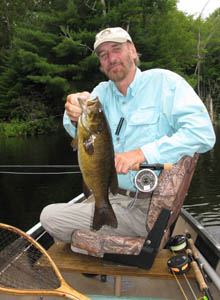
Tim with a fine Penobscot River smallie
The Penobscot
Here the upper Penobscot isn’t nearly as big as it is below Bangor, but it is still a major waterway over 100 yards wide. Even though a road parallels much of the river, housing and other development is sparse. Best of all, with a mix of boulders, rubble and gravel, the clear-flowing upper Penobscot from Howland to Medway is beautiful-looking smallmouth water.
I should also add that it’s lightly fished. Very lightly fished. Mainers focus on trout and landlocked salmon with religious devotion, utterly disregarding smallmouth and other warmwater species. Most visiting anglers also overlook Maine’s warmwater rivers. So many days you can look up and down the river and not see another human.
Wading the Tribs
Dan and I wanted to fish a variety of water, so each day it was a different location. And we used different modes of locomotion to cover water. A couple days we wade fished two of the Penobscot’s major tributaries, the East Branch and the Mattawamkeag rivers.
If the Penobscot is lightly fished, then the Mattawamkeag is unfished. One of the most boulder-strewn streams I’ve seen, its riffles can be tricky to float or wade. Excitedly charging into the stream, I immediately slipped on the slick boulders and soaked almost everything in my vest. I was more careful after that, and I spread my wet gear on a flat rock where the warm August sun quickly dried everything out.
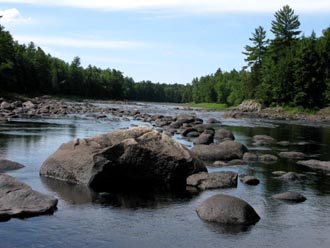
The fishy and boulder-strewn Mattawamkeag River
We caught a bunch of smallies wading both the tribs, but the extra clear water made for a tough mid-day bite for the bigger fish. It wasn’t until the sun set on the East Branch that the bigger bronze appeared. Dan hooked the largest that evening, a sleek 19-incher on a black Shenks Streamer.
Damselfly Surprise
It turns out that these wading days were just a warm-up for what was to come. The first time we floated the Penobscot we noticed a couple jumping fish in the distance. I’m used to carp and suckers doing this, so didn’t give it much thought. But then a much closer fish jumped and I could see it was a smallie and, surprisingly, it seemed to be trying to catch a Damselfly. I’d only rarely seen this before, but quickly another fish jumped, so it was no fluke. We immediately put on topwaters and the excitement began.
Working a Bitty Blockhead or foam Roundhead randomly across mid-river flats brought up some fish. But quickly casting to where a fish had just broke the surface was the prime technique. We slowly moved down river taking turns rowing while the other cast. And man did we catch ’em. It was 56 fish one day, 51 another day and nearly that many on another float. While Damselflies (a small cousin of Dragonflies) have very little bulk, we realized that in the low-nutrient upper Penobscot when these insects were hovering over the river, the smallmouth obviously felt they were worth eating. And many of the 13- to 16-inchers we caught regurgitated a dozen or more flies. As hot as the topwater bite was in the middle of the day, when the sun set and the Damselflies retreated to shore, the bite stopped dead.
Smallies in the Pads
We did find one local angler who liked smallies. We stopped at the impounded river near Howland one day, and a person (noticing our out-of-state plates) pulled up and asked what we were fishing for. When we said smallmouth, he excitedly said he was the only local he knew who also liked them and quickly gave us a where-to-go tip. Up a narrow side channel next to the boat landing was an impounded tributary called Merrill Brook. He said bigger fish resided there. So with our 4-horse outboard pushing the Old Town Sportboat we headed up the arm until lily pads became prevalent. Using topwaters, we caught numerous 16- to 18-inch smallies in the clumps of pads. Unusual habitat for smallmouth, no doubt, but the fish were certainly doing well in there.
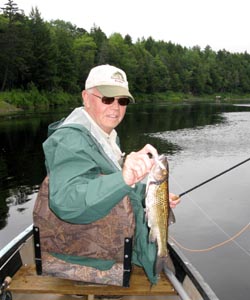
Dan with a 14-inch Fallfish, very abundant in Maine
Rounding it Out
We also fished another impounded section of the Penobscot. Backed up by a dam near Jordan Mills, the river here becomes wide with a large island in the middle. Though it was a weekend, this undeveloped, forested impoundment had no other anglers in sight. Shorelines here are classic North Country boulders and downed timber, with nice smallies that wanted black or yellow Hares.
Rounding out the 8 days of fishing, we floated the lower East Branch on the one drizzly day of the trip. The fish really appreciated the reduced light intensity, and we caught almost 4 dozen mid-sized smallmouth and at least that many fallfish, in just 5 hours. In fact, huge 12- to 14-inch fallfish are abundant throughout the watershed and every day we caught lots of them, often on smallmouth poppers.
After these 8 great days, we said goodbye to wild and wonderful Maine and headed to Pennsylvania. But that’s another story….
— Excerpted from the book “Adventures of a Fishing Bum — 27 True Tales.”
Read More Adventure Tales:
If You Go…
> The Penobscot from Bangor to Medway is all good water, and so are its major tributaries: the Mattawamkeag, Piscataquis and East Branch. These can all be floated by canoes, kayaks or small pontoons, unless water levels are exceptionally low.
> If you wade-fish the Mattawamkeag, beware of slippery rocks. I am a skilled wader, but when I fished there again this year, I slipped and fell in once again.
> Due to the cooler, lower nutrient waters, smallies are thinner than the upper Midwest, but sleek 18- and 19-inchers are available.
> Lincoln and Medway both have restaurants and nice, reasonably-priced motels. Pine Grove Campground by Medway also has inexpensive riverside cabins.
> With the area’s depressed economy (due to downturns in the logging industry) we easily found locals happy to shuttle us for a small fee.



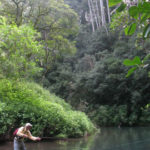
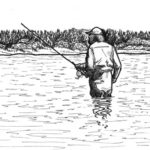
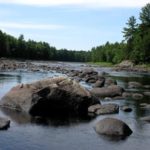
No comments yet.